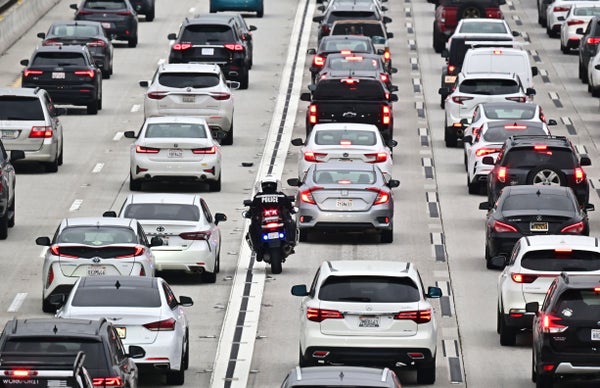As world leaders gathered in Dubai for the annual United Nations climate summit, each nation’s efforts to reduce greenhouse gas emissions were put on display. The U.S. touted its Inflation Reduction Act (IRA), which commits more than $350 billion over a decade toward clean energy initiatives, including big investments in the electric vehicle (EV) industry. These investments come at a time when demand for EVs has grown steadily in the U.S. and around the world.
EVs are a promising technology for reducing greenhouse gas emissions from passenger vehicles. But those emissions reductions come with an apparent paradox: because every mile driven in an EV replaces a mile driven in a gasoline vehicle, more miles equals lower emissions. Replacing the top 20 percent highest-mileage gasoline vehicles with EVs would reduce annual greenhouse gas emissions by more than 15 times as much as replacing vehicles in the bottom 20 percent lowest-mileage.
Unfortunately, EV owners aren’t yet putting on the miles needed to realize those reductions.
On supporting science journalism
If you're enjoying this article, consider supporting our award-winning journalism by subscribing. By purchasing a subscription you are helping to ensure the future of impactful stories about the discoveries and ideas shaping our world today.
Used car buyers, however, could turn this trend around. Right now the U.S. has a large fleet of lightly used EVs available for sale (and at rather competitive prices). Higher-mileage drivers could benefit greatly from lower operating and maintenance costs while also benefiting the environment if they considered adopting a used EV—and especially if, in doing so, they took an older, higher-polluting vehicle off the road. The government should reconsider popular programs such as “Cash for Clunkers” to subsidize the rapid removal and replacement of these older gas cars with cleaner EVs, especially used ones.
Studies have consistently found people are driving their EVs less than their gas cars. In our most recent one, my co-authors and I conducted an extensive analysis of odometer readings from 12.5 million used cars and 11.4 million used SUVs listed between 2016 and 2022. We found that EVs averaged just 7,165 annual miles driven, compared to 11,642 for gas vehicles. A 2021 study found similar results when it examined the increase in household electricity usage after purchase of an EV to estimate mileage, as did a similar analysis of used vehicle listings by iSeeCars.com this June.
But on its latest analysis the Environmental Protection Agency concluded EV owners are driving their cars about the same number of miles as owners of gas vehicles. This could lead to an overestimation of emissions savings from EVs and potentially less-strict emissions regulations for gasoline vehicles.
That EVs are accumulating miles at a lower rate than their gasoline counterparts is not necessarily surprising. Studies have shown that most households that own an EV have multiple vehicles, and people may be using their gasoline vehicle on longer trips while reserving their EV for shorter local trips. In our study, we find evidence that households with multiple vehicles do indeed drive their secondary vehicle less, though the annual mileage gap is not as severe as the gap between EVs and gasoline vehicles.
People who drive less may also disproportionately purchase EVs—a plausible outcome, given that EVs have limited driving ranges and limited charging infrastructure in many parts of the U.S. Researchers have also found that “range anxiety”—a fear of running out of charge in an EV—can affect driving patterns, resulting in overall less driving.
While we still need research to understand the underlying causes behind lower EV mileage, our study does point to what conditions will help increase it. For one, we observed that higher-range cars and those with well-established fast-charging infrastructure (like Tesla’s) were driven significantly more, though still less than their gas counterparts. Likewise, the EV-gas mileage gap was much smaller for SUVs.
These findings suggest that as the industry matures, the introduction of more electric trucks and SUVs (along with far more charging infrastructure) will likely lead to higher EV mileage and greater environmental benefits. In the meantime, the used market will play an important role in introducing gas car drivers to their first EV, which the U.S. government could support more (on top of the $4,000 used EV subsidy offered in the IRA).
The U.S. pivot toward EVs is both commendable and necessary. As the EV market matures, with newer models introduced and charging infrastructure built out, we can expect to realize meaningful emissions savings. For the time being, however, we should ground our expectations and strategies for decreasing emissions in real-world data that allow policy makers to make informed decisions.
This is an opinion and analysis article, and the views expressed by the author or authors are not necessarily those of Scientific American.
